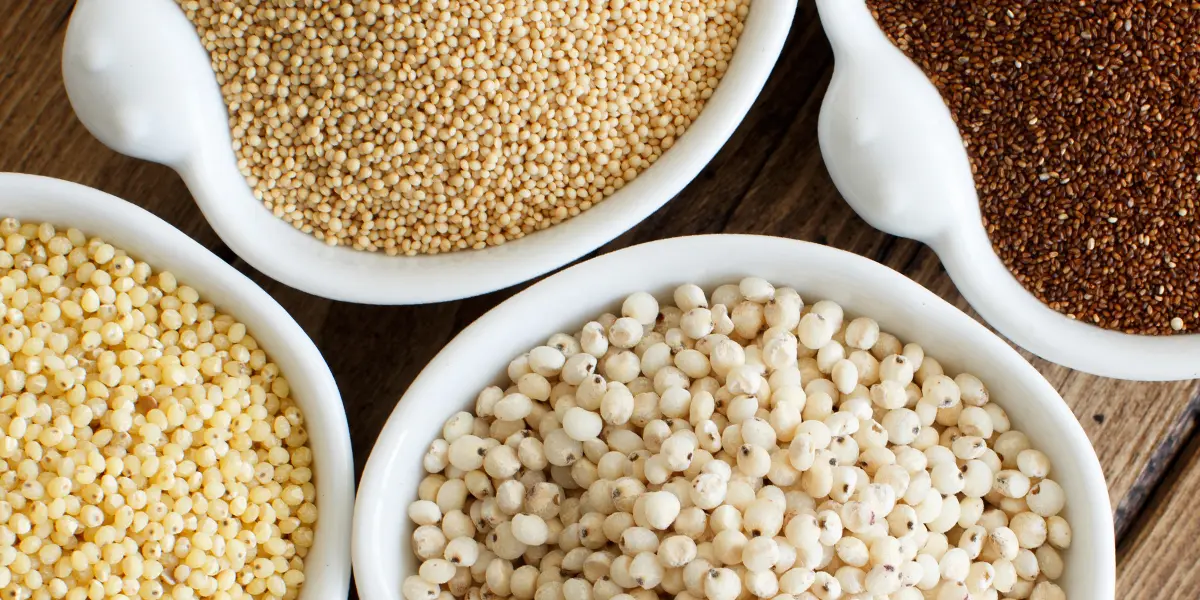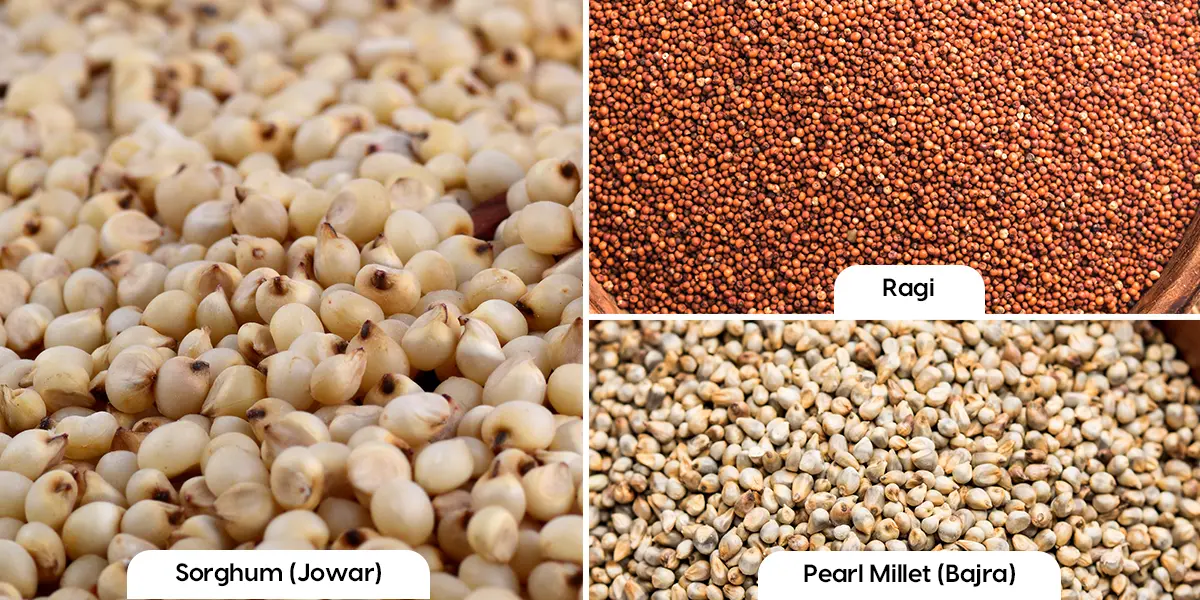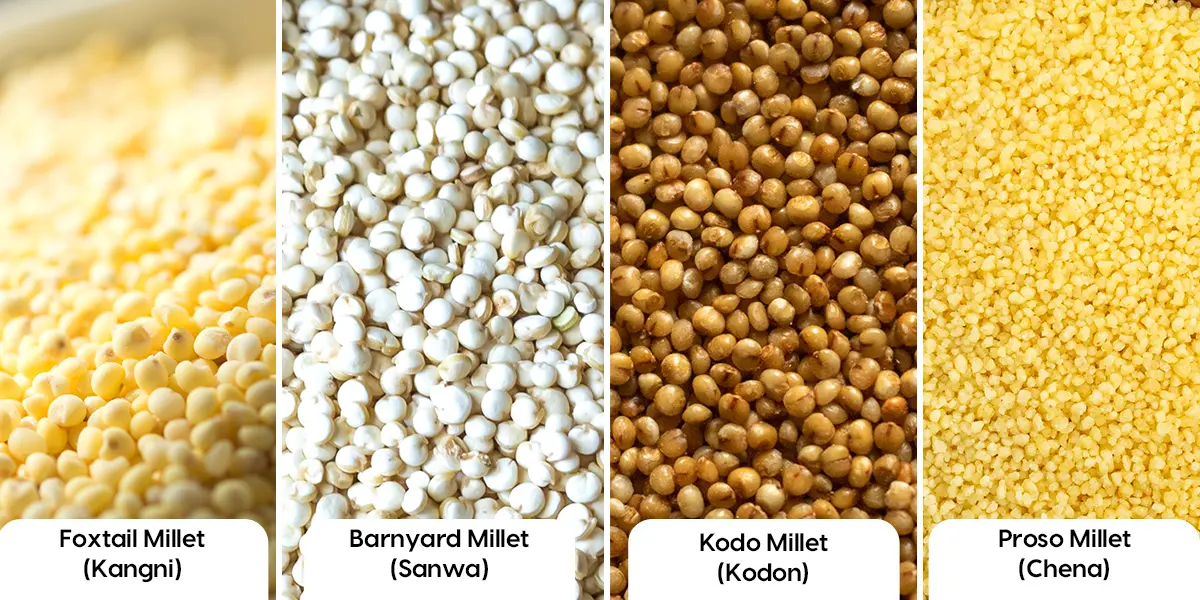Are Millets Good for Weight Loss?

We’ve all been hearing so much about millets these days! Almost everyone talks about how awesome they are, so much so that 2023 was even celebrated as the Year of Millets!
From millet biscuits to millet atta, noodles, pasta, and even millet bread, it feels like there’s a millet variant for almost everything now. But beyond the hype, if you’re serious about millets for weight loss, what’s the real benefit?
Let’s see why these small grains are making such a big difference for people looking to shed those extra kilos and adopt a healthier lifestyle.
What Are Millets?
Millets are a group of small-seeded grains, which are cultivated for thousands of years and are a staple food in many parts of the world, especially in India. They are highly valued for their rich nutrient content, being naturally gluten-free, and packed with fiber, protein, vitamins, and minerals like iron, calcium, and magnesium. Millets are known for their versatility and can be used in a wide range of dishes.
Millets are divided into minor millets and major millets:
1. Major Millets

These are larger grains.
While nutritious, they have a higher glycemic index (56-65) than minor millets (35-54) and are not as recommended for weight loss compared to minor millets. Examples include Sorghum (Jowar), Pearl Millet (Bajra), and Ragi.
2. Minor Millets


These are smaller than major millet grains.
They are more beneficial for weight loss and better for managing blood sugar. They include Foxtail Millet (Kangni), Barnyard Millet (Sanwa), Kodo Millet (Kodon), Little Millet (Kutki), and Proso Millet (Chena).
What are the Nutritional Value of Millet?
Millets are known for their rich nutritional profile. They contain fiber, protein, vitamins, and minerals like magnesium, phosphorus, and iron.
These grains are high in fiber, making them ideal for weight management. Their low glycemic index helps control blood sugar levels, another key factor when you’re aiming for millet for weight loss. Below are the nutritional values per 100 grams of minor millets:
| Nutrient | Foxtail Millet
(kangni) |
Barnyard Millet
(sanwa) |
Kodo Millet
(kodon) |
Little Millet
(kutki) |
Proso Millet
(chena) |
Brown Top Millet
(korale) |
| Energy (kcal) | 473 | 307 | 309 | 329 | 341 | 336 |
| Protein (gm) | 12 | 6 | 8 | 8 | 13 | 9 |
| Fiber (gm) | 8 | 10 | 9 | 8 | 3 | 7 |
| Calcium (mg) | 31 | 20 | 27 | 17 | 14 | 28 |
| Phosphorus (mg) | 258 | 293 | 189 | 207 | 277 | 276 |
Which Millet is Good for Weight Loss?
Based on various studies, minor millets have more health benefits than major millets, particularly when it comes to weight management and metabolic health. Research shows that minor millets such as foxtail millet, barnyard millet, and kodo millet contain higher levels of dietary fiber and antioxidants, which are essential for promoting digestive health, lowering blood sugar levels, and aiding in weight loss.
These grains also have a lower glycemic index (GI), making them beneficial for managing blood glucose, a key factor for those looking to lose weight or manage diabetes.
While major millets like bajra and jowar are also nutrient-dense, their higher glycemic index may not be as suitable for diabetes and weight management compared to minor millets.
Here is a video featuring Dr Arbinder Singal, CEO and Co-founder of Fitterfly, where he talks about why millets don’t suit everyone, specifically when you have diabetes:
What are the Benefits of Millets for Weight Loss?
Millets offer several benefits for weight loss due to their nutritional profile and versatility. Here’s how millets can support weight loss:
1. Improves Satiety and Reduces Hunger (High Fiber Content)
Millets, especially barnyard and kodo, are high in dietary fiber, which enhances satiety and reduces hunger. Studies have shown that a fibre-rich diet can help reduce body weight by promoting fullness, thus lowering overall calorie intake.
2. Low Glycemic Index
Minor millets have a low glycemic index, which helps control blood sugar levels and prevent insulin spikes that can lead to fat storage.
3. Metabolism and Energy Levels (Rich in Nutrients)
Millets are rich in B vitamins like niacin, riboflavin, and folate, which support metabolism and energy production. Maintaining a higher metabolic rate helps burn more calories, which is crucial for weight loss.
4. Improve Lipid Profile
Regular consumption of millet can improve the lipid profile, helping reduce cholesterol and fat mass. This is especially beneficial for individuals aiming to lose weight by reducing fat storage and supporting overall cardiovascular health.
5. Gluten-Free Grain
Millets are a naturally, gluten-free grain, making them a safe and effective option for those with gluten sensitivity or celiac disease. Gluten-free diets are often lower in unhealthy processed foods, which can contribute to weight gain, making millet a healthier, nutrient-dense alternative.
Is your weight increasing your health riskHealthy Weight
Calculator
What is a Millet Diet Plan for Weight Loss?
A millet diet plan for weight loss involves replacing traditional grains like rice or wheat with various types of minor millets, ensuring you use equal grammage (quantity) to maintain proper nutritional intake.
Minor millets like foxtail millet, barnyard millet, kodo millet, little millet, and proso millet are rich in fiber and nutrients, making them perfect for weight management.
Here’s how you can integrate minor millets into your diet:
1. Swap Wheat Roti with Millet Roti
When replacing wheat chapatis with millet-based rotis, make sure to use the same amount by weight (grammage) for consistency in nutrient intake. You can use foxtail millet or little millet flour to prepare rotis, ensuring you don’t overconsume calories while still benefiting from their high fiber and low glycemic properties.
2. Use Minor Millets for Breakfast
Replace traditional wheat or rice-based dosa and idli with foxtail millet dosa or barnyard millet idli in the same gram quantity. This ensures you get the energy you need while managing your calorie intake efficiently.
3. Millets in Snacks
For snacks like millet khichdi or millet porridge, use the same grammage as you would for rice-based snacks. Using kodo millet or little millet in equal amounts helps you maintain a balanced diet while benefiting from the high nutrient density of millet.
4. Millets for Lunch or Dinner
When substituting rice with millet in dishes like millet pulao or barnyard millet biryani, measure the millet to match the amount of rice you typically use. This keeps your meal portions balanced and ensures you get the right amount of calories and nutrients.
What are the Potential Harmful Effects of Millets?
While millets are beneficial for weight loss, there are some side effects to consider, even with minor millets:
- High Glycemic Index in Major Millets: Ragi has a high GI, which can spike blood sugar, making it less ideal for weight loss and for people with diabetes.
- Digestive Issues: Consuming too many millets, including minor millets, can cause bloating or gas due to their high fiber content.
- Mineral Absorption: Millets contain phytic acid, which can reduce the absorption of important minerals like iron and calcium.
- Excess Consumption of Millets: Eating too much of even minor millets may lead to nutrient imbalances, as they can crowd out other essential grains and foods.
| NOTE: Stick to moderate portions of minor millets for balanced and effective weight loss. |
How to Use Millets for Weight Loss?
You can incorporate millets into your diet in various ways. Replace wheat and rice with millets in your rotis, upmas, porridge, and even desserts.
Remember to keep the grammage equivalent to ensure you’re getting the same amount of nutrients and energy. For example, if you usually have 2 atta roti, you can replace that with 2 millet roti – and not more.
What are the Millet Recipes for Weight Loss?
Here are some quick and healthy minor millet recipes for weight loss:
- Foxtail Millet Salad: Toss cooked foxtail millet with fresh veggies, olive oil, and lemon juice for a light and filling salad.
- Minor Millet Dosa: Blend kodo flour with water and salt, make thin dosas, and serve with chutney.
- Barnyard Millet Porridge: Cook barnyard millet with milk or water for a wholesome and nutritious breakfast.
- Millet Roti: Use foxtail millet or little millet flour to make rotis and pair with a low-calorie curry.
- Millet Upma: Make upma with proso millet or little millet for a filling and fibre-rich meal.
- Millet Idli: Prepare soft idlis using foxtail millet or barnyard millet for a healthy, low-calorie breakfast.
What is the Best Time to Eat Millets for Weight Loss?
You can enjoy millet at any time of the day, but they are especially great for breakfast or lunch when your metabolism is at its peak. This will give you sustained energy throughout the day without causing a spike in your blood sugar.
Lost 22 kg in just 3 months!


70kg
Happy members
EMI
Guarantee
4.8/5
Weight Loss Program
How We At Fitterfly Can Help You?
At Fitterfly, we make your weight loss journey simpler with our personalized approach. Our team, including a Success Coach, Nutrition Coach, and Fitness Coach, works together to create a plan that suits your needs.
Our Nutrition Coach always emphasizes the inclusion of minor millet, such as Foxtail Millet, Barnyard Millet, and Little Millet, in your diet. These millets are fibre-rich, have a low glycemic index, and help you feel fuller for longer, making them ideal for weight loss. They support balanced nutrition while managing blood sugar levels and keeping hunger in check.
Alongside this, your Success Coach helps set achievable goals, keeping you motivated, while the Fitness Coach creates a workout plan tailored to your diet and lifestyle. We closely monitor your progress, adjusting your plan to ensure you’re always moving in the right direction.
Give us a missed call at 08068507599, and let us guide you to healthier living!
This blog provides general information for educational and informational purposes only and shouldn't be seen as professional advice.
Frequently Asked Questions
Which millet is best for PCOS weight loss?
Foxtail millet and barnyard millet (instead of pearl millet/bajra) are great choices for managing PCOS and supporting weight loss due to their high fiber and nutrient content.
Which millet is best for daily use?
Foxtail millet or little millet are good options for daily use as they are low in calories and rich in nutrients.
Which millet is best for belly fat loss?
Minor millets, low in calories and high in fiber, may help manage belly fat and overall weight by promoting fullness and stable blood sugar as part of a balanced diet.
Which is better for weight loss, oats or millet?
Both are excellent choices, but minor millets may have an edge due to their variety of nutrients and lower glycemic index.
Which millet is best for women's health?
Minor millets like Little Millet (Kutki) and Kodo Millet (Kodon) are great for women's health. Little Millet is high in fiber, improving digestion and supporting hormonal balance. Kodo Millet offers antioxidants that support heart health and overall wellness. These millets also help with weight management, making them a smart choice for women's daily diet.
Which is the best millet for weight loss?
All minor millets are good for weight loss. However, barnyard millet, foxtail millet, and little millet are particularly beneficial.



















